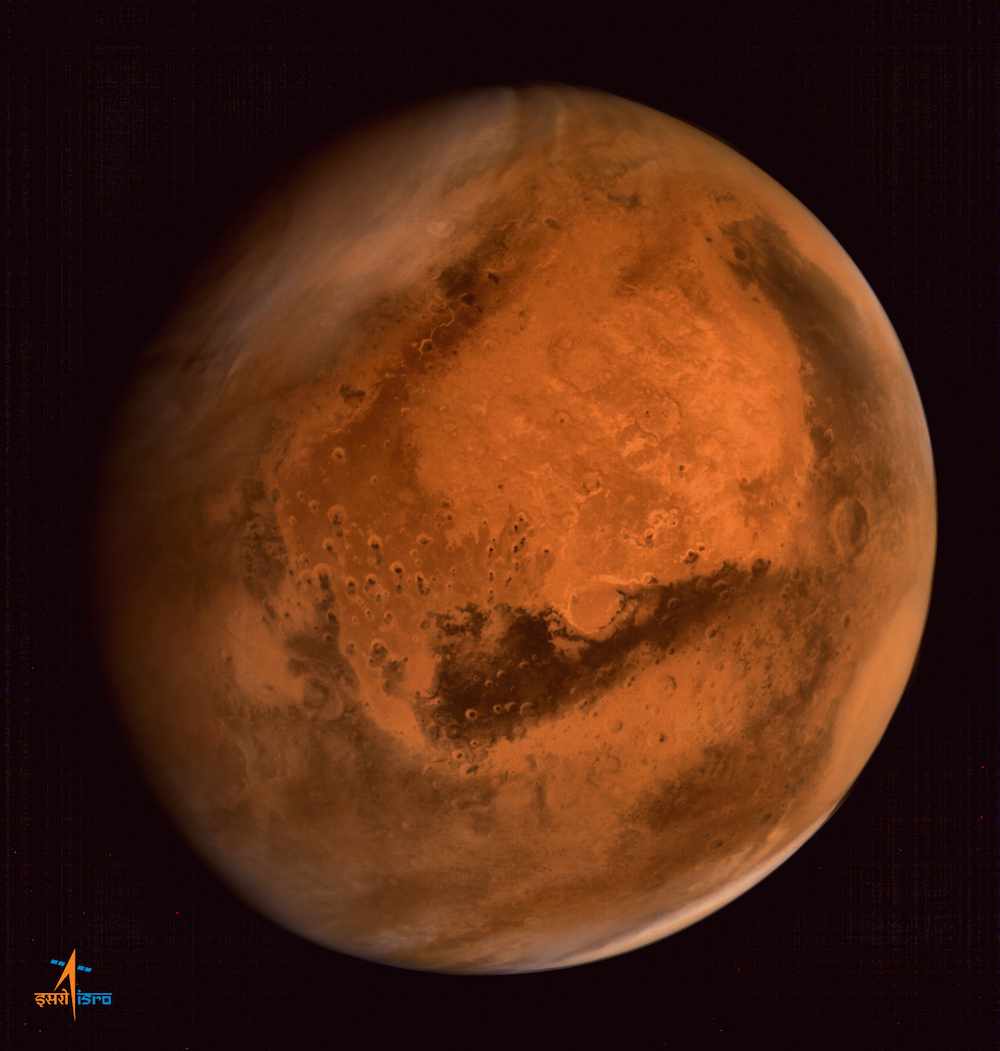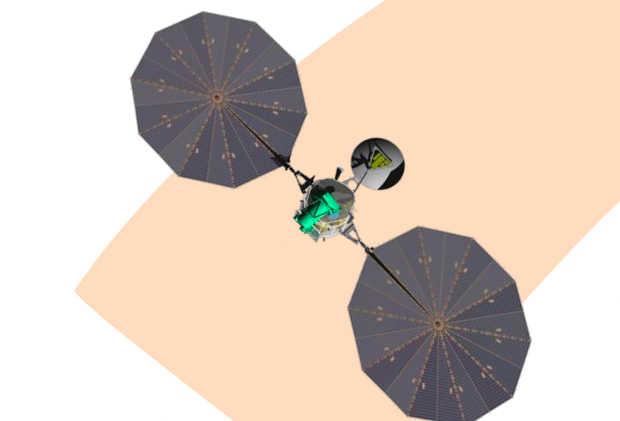
NASA officials want the agency’s next Mars orbiter to pull double duty as a communications relay station for a fleet of surface landers and as a trailblazer for a future round-trip sample return mission and human expeditions to the red planet.
Worried its fleet of Mars orbiter is aging, NASA intends to dispatch the spacecraft to the red planet in September 2022 to link ground controllers with rovers and extend mapping capabilities expected to be lost when the Mars Reconnaissance Orbiter stops functioning.
Engineers also want to add ion engines to the orbiter and fly the efficient electrically-powered thruster system to Mars for the first time, testing out a solar-electric propulsion package that officials say will be needed when astronauts visit the red planet.
Ion engines produce just a whisper of thrust, using electric power to ionize atoms of a neutral gas and spit out the particles at high speed. While the drive given by the thrusters is barely noticeable in one instant, they can operate for months or years, burning scant fuel compared to traditional chemical rockets.
A Mars orbiter launching in 2022 is a prime candidate to test out new technologies — like ion drive engines, better solar arrays, and lightning-fast broadband communications between Earth and Mars — to help scientists return samples from the Martian surface, and eventually send humans there, according to Charles Whetsel, who oversees formulation of future Mars missions at NASA’s Jet Propulsion Laboratory in Pasadena, California.
“The ability to do round-trip missions, including robotic sample return, but also paving the way for human exploration, is a very high priority for the agency,” Whetsel said in a Feb. 24 meeting of the Mars Exploration Program Analysis Group, a panel of scientists chartered by NASA to help plan future scientific research at the red planet.
A rover NASA plans to send to Mars in 2020 will scoop up rock samples and store them for retrieval on a later mission. An orbiter with ion engines to get the material back to Earth will come later, along with a rocket to launch the specimens from Mars into space for pickup by the return craft.
Adding solar-electric propulsion to the 2022 Mars mission would allow the probe to swoop through different orbits around the red planet, passing by the Martian moons Deimos and Phobos and through a so-called “areostationary” orbit about 11,000 miles above the Mars equator.
The areostationary orbit is similar to the type of orbit around Earth used by communications satellites, which circle the planet at the same speed as its rotation, appearing to hover over a fixed location.
Such an orbit is ideal for communications, but most scientific observations of Mars require a closer viewpoint.
That is not a problem with solar-electric propulsion, said Robert Lock, who is leading the concept studies for the 2022 orbiter.
An orbiter equipped with ion engines — and highly-efficient solar panels to generate the power for the thrusters — would likely launch into a high-altitude Earth orbit, then fire its electric rocket jets to gradually break free of Earth’s gravity and fly to Mars. Instead of the usual transit time of less than a year, it might take two years for a probe with ion propulsion to get to the red planet, where it would initially enter a looping orbit far from Mars, before using its electric engines spiral closer.
“(Solar-electric propulsion) is easy,” Lock told NASA’s Mars science panel Feb. 24. “It’s like an electric light switch. You turn the motor off, do some science, turn the motor back on and continue spiraling. Doing science on the way through the Mars system is actually a very easy thing to do, and you’ve got loads of power to do it with.”

Lock said in-space electric propulsion — thought of as an unproven cutting edge technology not long ago — is now mature enough to rely on for a robotic mission to Mars. He said the 2022 probe could mark the start of a new generation of Mars orbiters, much like the way the Mars Reconnaissance Orbiter — with its telescopic imaging camera, sounding radar and large size — represented a leap in capabilities when it lifted off in 2005.
NASA’s Dawn spacecraft now approaching the dwarf planet Ceres would not be possible without ion engines, and a pair of Boeing-built communications satellites launched just Sunday using only xenon-ion propulsion to complete their missions.
“In the decade since MRO was launched and got to Mars, significant new things have happened,” Lock said. “Deep Space 1 and Dawn proved that electric propulsion can be taken out into the solar system and used successfully. In the meantime, our commercial friends were using electric propulsion to replace complex and risky chemical propulsion systems to do their jobs easier and more cheaply for telecom satellites.”
NASA could elect to send an orbiter to Mars with conventional liquid-fueled propulsion system, purely as a replacement for the communications relay and scientific survey capacity from previous missions.
But Whetsel and Lock said infusing the 2022 mission new technologies like electric propulsion or high-speed optical communications would expand the orbiter’s scientific output while simultaneously paving the way for later voyages.
“Getting to Mars and then getting back again with sample return is turning out not to be so much of a challenge if we start off with a solar-electric propulsion type basis,” Lock said.
According to Lock, one orbiter design under discussion is based on the probe NASA has proposed sending to collect an asteroid and return it to the vicinity of the moon for a visit by astronauts. The Mars mission model based on the asteroid retrieval mission would have enough power from its ion engines to launch to the red planet and return to Earth, and still fit in the envelope of a Falcon 9 or low-end Atlas 5 rocket, he said.

Officials said all the concepts under consideration for the 2022 mission are targeted to cost between about $500 million and $1 billion, in line with NASA’s most recent Mars orbiters. If the orbiter includes things that apply to future human expeditions to Mars, the cost could be shared among NASA’s science, human exploration and space technology divisions, which each have their own funding lines.
Lock pitched using ion drives on the 2022 mission to the Mars science community by highlighting how the orbiter could support more scientific sensors than existing probes. The electric thrusters are power-hungry, requiring upgraded solar panels to charge the spacecraft’s batteries, but that leaves extra power for research instruments when the engines are switched off.
“We have a lot of capability, and the trick is going to be dialing in who wants what out of the mission, who is going to contribute what to the mission, and how do we share the landscape in terms of funding all the things we want to do,” Lock said.
NASA also has a more logistical reason behind the mission: Officials are not sure how many of the space agency’s existing orbiters will still be working by the early 2020s.
Launch opportunities for Mars missions are spaced approximately 26 months apart, when the planets are properly aligned to make the interplanetary journey feasible.
Engineers will spend the next year studying several concepts for the 2022 mission, and officials hope to finalize the orbiter’s purpose and architecture in time to kick off development by the end of 2016, according to Jim Watzin, head of NASA’s Mars exploration program at NASA Headquarters.
NASA’s network of spacecraft circling Mars — currently consisting of the Mars Odyssey probe, the Mars Reconnaissance Orbiter, and the MAVEN mission — may be whittled down to as few as one by 2022.
Besides science data collected by the orbiters, the spacecraft are critical to support landers and rovers parked on the Martian surface. They relay signals between Earth and the craft on Mars, enabling the return of imagery, data and telemetry at a much faster rate than possible with direct links.
“One of my biggest worries is some of our spacecraft are getting old,” said Fuk Li, director of Mars programs at JPL. “Looking into the early ’20s and having an orbiter around (Mars) to provide a rejuvenation of communications and reconnaissance capability is one of the critical things we can add to the program. It provides a lot more resiliency and robustness to how we do operations around Mars.”

Mars Odyssey — in orbit since October 2001 — is battling problems with reaction wheels it uses for pointing, and MRO will mark a decade since its launch later this year. MAVEN is a newcomer to Mars after it arrived in September.
The European Space Agency’s Mars Express mission is also in orbit and can beam back data from the rovers, but it has been at Mars since December 2003.
The next two U.S. missions to Mars will go to the surface. The InSight lander will launch in March 2016 and measure seismic activity from a stationary position near the Martian equator, and modified copy of the Curiosity rover is set to blast off toward the red planet in July 2020.
The focus on surface missions leaves a gap in new U.S. orbiters.
ESA is in the final stages of building a methane-sniffing orbiter for launch on a Russian Proton rocket in January 2016. It will host a U.S.-made Electra radio package to connect with the Curiosity and Opportunity rovers, giving them a new conduit to send back results to scientists on Earth.
India’s Mars Orbiter Mission, which reached the red planet in September, does not carry the radio system required for linkups with the rovers.
“Although there’s a lot of open territory and a lot of landscape to be explored in the coming decade, we’ve done enough exploration of that to understand that building from the 2020 surface mission … it feels like the right thing to do is to move forward with an orbiter mission concept,” Whetsel said.
“We’ve been exploring what that orbiter might look like,” Whetsel said. “We don’t have one firm concept. We’ve got a family of concepts, but we know enough about those now to reach out to the science community and talk about the different capabilities that orbiter might have.”
Follow Stephen Clark on Twitter: @StephenClark1.



